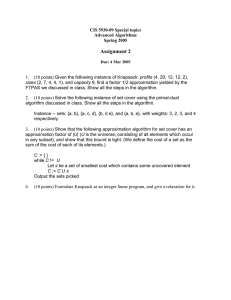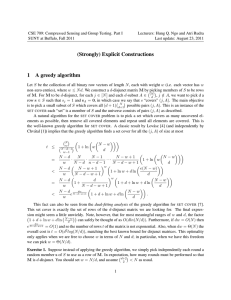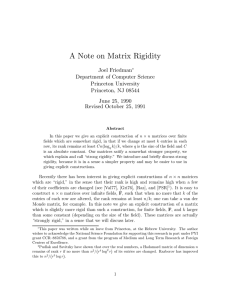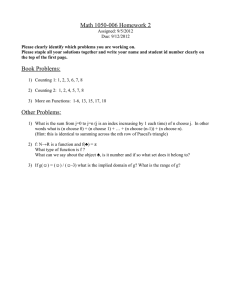A DETERMINISTIC POLYNOMIAL-TIME APPROXIMATION SCHEME FOR COUNTING KNAPSACK SOLUTIONS
advertisement
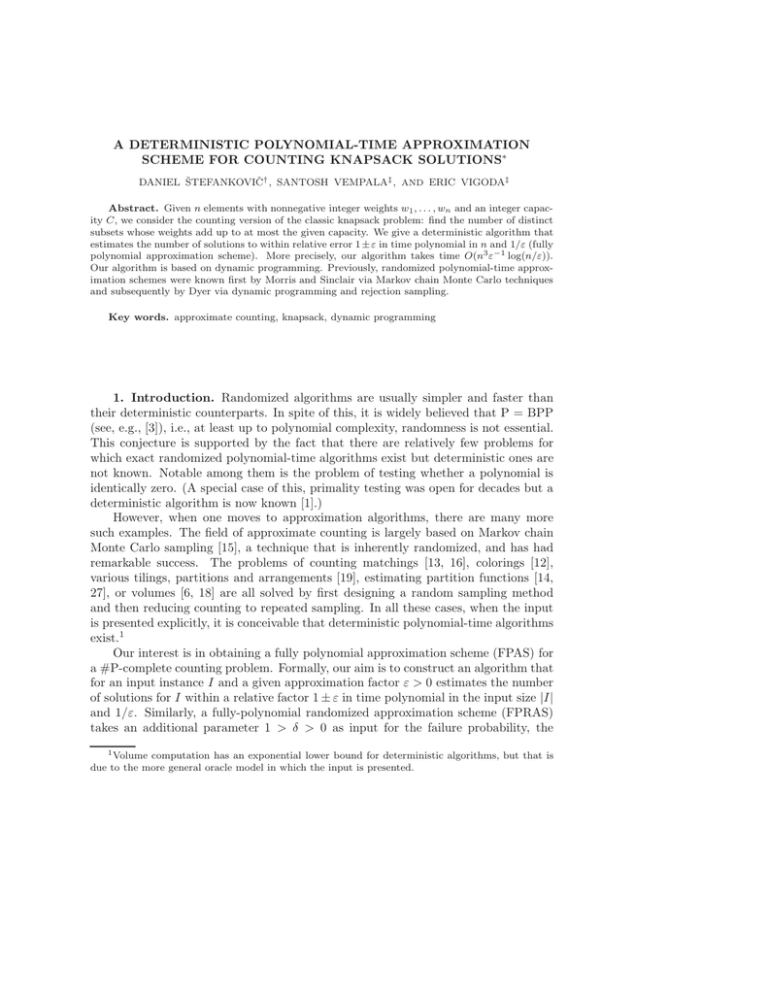
A DETERMINISTIC POLYNOMIAL-TIME APPROXIMATION
SCHEME FOR COUNTING KNAPSACK SOLUTIONS∗
DANIEL ŠTEFANKOVIȆ , SANTOSH VEMPALA‡ , AND ERIC VIGODA‡
Abstract. Given n elements with nonnegative integer weights w1 , . . . , wn and an integer capacity C, we consider the counting version of the classic knapsack problem: find the number of distinct
subsets whose weights add up to at most the given capacity. We give a deterministic algorithm that
estimates the number of solutions to within relative error 1 ± ε in time polynomial in n and 1/ε (fully
polynomial approximation scheme). More precisely, our algorithm takes time O(n3 ε−1 log(n/ε)).
Our algorithm is based on dynamic programming. Previously, randomized polynomial-time approximation schemes were known first by Morris and Sinclair via Markov chain Monte Carlo techniques
and subsequently by Dyer via dynamic programming and rejection sampling.
Key words. approximate counting, knapsack, dynamic programming
1. Introduction. Randomized algorithms are usually simpler and faster than
their deterministic counterparts. In spite of this, it is widely believed that P = BPP
(see, e.g., [3]), i.e., at least up to polynomial complexity, randomness is not essential.
This conjecture is supported by the fact that there are relatively few problems for
which exact randomized polynomial-time algorithms exist but deterministic ones are
not known. Notable among them is the problem of testing whether a polynomial is
identically zero. (A special case of this, primality testing was open for decades but a
deterministic algorithm is now known [1].)
However, when one moves to approximation algorithms, there are many more
such examples. The field of approximate counting is largely based on Markov chain
Monte Carlo sampling [15], a technique that is inherently randomized, and has had
remarkable success. The problems of counting matchings [13, 16], colorings [12],
various tilings, partitions and arrangements [19], estimating partition functions [14,
27], or volumes [6, 18] are all solved by first designing a random sampling method
and then reducing counting to repeated sampling. In all these cases, when the input
is presented explicitly, it is conceivable that deterministic polynomial-time algorithms
exist.1
Our interest is in obtaining a fully polynomial approximation scheme (FPAS) for
a #P-complete counting problem. Formally, our aim is to construct an algorithm that
for an input instance I and a given approximation factor ε > 0 estimates the number
of solutions for I within a relative factor 1 ± ε in time polynomial in the input size |I|
and 1/ε. Similarly, a fully-polynomial randomized approximation scheme (FPRAS)
takes an additional parameter 1 > δ > 0 as input for the failure probability, the
1 Volume computation has an exponential lower bound for deterministic algorithms, but that is
due to the more general oracle model in which the input is presented.
output of the algorithm is correct with probability ≥ 1 − δ, and the running time is
required to be polynomial in log(1/δ).
There is a line of work concerned with approximate counting of satisfying assignments of disjunctive normal form (DNF) formulas, beginning with the FPRAS of
Karp and Luby [17]. An FPAS for the #DNF problem when every clause is constant
length follows from work of Ajtai and Wigderson [2]; see Luby and Velic̆ković [20,
Corollary 13].
A notable recent example of an FPAS for a #P-complete problem is Weitz’s
algorithm [30] for counting independent sets in graphs of maximum degree Δ ≤ 5.
More generally, Weitz’s FPAS counts independent sets weighted by a parameter λ > 0
for graphs of maximum degree Δ when Δ is constant and λ < λc (Δ), where λc (Δ) =
(Δ − 1)Δ−1 /(Δ − 2)Δ is the so-called uniqueness threshold on the infinite Δ-regular
tree. Recently, Sly [26] showed that there is no polynomial-time approximation scheme
(unless NP = RP) for estimating this sum of weighted independent sets on graphs of
maximum degree Δ for λ satisfying λc (Δ) < λ < λc (Δ) + εΔ for some εΔ > 0 (in [8]
the assumption λ < λc (Δ) + εΔ is removed for all Δ = 3, 4). Weitz’s approach was
later extended to counting all matchings of bounded degree graphs [4]. An alternative,
related approach of Gamarnik and Katz [9] gives an FPAS for k-colorings of trianglefree graphs with maximum degree Δ when Δ is a sufficiently large constant and
k > 2.84 . . . Δ. One limitation of Weitz’s approach and related works is that the
running time is quite large, in particular, the exponent depends on log Δ. In contrast,
our algorithm has a small polynomial running time.
Here we consider one of the most basic counting problems, namely, approximately
counting the number of 0/1 knapsack solutions. More precisely, we are given a list of
nonnegative integer weights w1 , . . . , wn and an integer capacity C and wish to count
the number of subsets of the weights that add up to at most C. From a geometric perspective, for the n-dimensional boolean hypercube, we are given as input an
n-dimensional halfspace, and our goal is to determine the number of vertices of the
hypercube that intersect the given halfspace. We give an FPAS for the problem, that
is, a deterministic algorithm that for any ε > 0 estimates the number of solutions to
within relative error 1 ± ε in time polynomial in n and 1/ε. Our algorithm is strongly
polynomial (see, e.g., [29, 21]), that is, it is polynomial-time and the number of arithmetic operations is polynomial in the dimension of the problem. Our algorithm also
satisfies the more stringent definition of “fully combinatorial” strongly polynomialtime algorithm (see, e.g., [24, 25]), since the only operations on numbers it uses are
additions and comparisons.
Our result follows a line of work in the literature. Dyer et al. [7] gave a randomized
subexponential time algorithm for this problem, based on near-uniform sampling of
feasible solutions by a random walk. Morris and Sinclair [23] improved this, showing
a rapidly mixing Markov chain, and obtained an FPRAS. The proof of convergence of
the Markov chain is based on the technique of canonical paths and a notion of balanced
permutations introduced in their analysis. In a surprising development, Dyer [5]
gave a completely different approach, combining dynamic programming with simple
rejection sampling to also obtain an FPRAS. Although much simpler, randomization
still appears to be essential in his approach—without the sampling part, his algorithm
only gives a factor n approximation.
Our algorithm is also based on dynamic programming, and similar to Dyer, it is
inspired by the pseudopolynomial algorithm for the decision/optimization version of
the knapsack problem. The complexity of the latter algorithm is O(nC), where C is
the capacity bound. A similar complexity can be achieved for the counting problem
as well using the recurrence
S(i, j) = S(i − 1, j) + S(i − 1, j − wi )
with appropriate initial conditions. Here S(i, j) is the number of knapsack solutions
that use a subset of the items {1, . . . , i} and their weights sum to at most j.
Roughly speaking, since we are only interested in approximate counting, Dyer’s
idea was the following: scale down the capacity to a polynomial in n, scale down
the weights by the same factor and round down the new weights, and then count
the solutions to the new problem efficiently using the pseudopolynomial-time dynamic programming algorithm. The new problem could have more solutions (since
we rounded down) but Dyer showed it has at most a factor of O(n) more for a suitable
choice of scaling. Further, given the exact counting algorithm for the new problem,
one gets an efficient sampler, then uses rejection sampling to only sample solutions to
the original problem. The sampler leads to a counting algorithm using standard techniques. Dyer’s
running time O(n3 + ε−2 n2 ) using the above approach
algorithm 2has
2.5
−2
−1
and O(n
log(ε ) + n ε ) using a more sophisticated approach that also utilizes
randomized rounding.
To remove the use of randomness, one might attempt to use a more coarse-grained
dynamic program, namely, rather than consider all integer capacities 1, 2, . . . , C, what
if we only consider weights that go up in some geometric series? This would allow us
to reduce the table size to n log C rather than nC. The problem is that varying the
capacity by an arbitrarily small additive factor can change the number of solutions
by more than a constant factor
√ (for example, if all the items have the same weight
n − 1, then increasing C by one changes the number of
w, n is a square, and
C
=
w
√n−1 n
√n n
solutions from i=0
to
i=0 i ).
i
Instead, we index the table by the prefix of items allowed and the number of
solutions, with the entry in the table being the minimum capacity that allows these
indices to be feasible. We can now consider approximate numbers of solutions and
obtain a small table.
Our main result is the following theorem.
Theorem 1.1. Let w1 , . . . , wn and C be an instance of a knapsack problem. Let Z
be the number of solutions of the knapsack problem. There is a deterministic algorithm
which for any ε ∈ (0, 1) outputs Z such that Z ≤ Z ≤ Z(1 + ε). The algorithm runs
in time O(n3 ε−1 log(n/ε)), assuming unit cost additions and comparisons on numbers
with O(log C) bits.
The running time of our algorithm is competitive with that of Dyer. One interesting improvement is the dependence on . Our algorithm has a linear dependence
on −1 (ignoring the logarithm term), whereas Monte Carlo approaches, including
Dyer’s algorithm [5] and earlier algorithms for this problem [23, 7], have running time
proportional to ε−2 .
A preliminary version of this paper was posted on the arXiv at [28]. Independently, Gopalan, Klivans, and Meka [10] posted a paper which presents a weakly
polynomial-time algorithm for the #Knapsack problem studied in this paper; in particular, their number of arithmetic operations depends on log C. They use a more
sophisticated approach, relying on read-once branching programs and insight from
Meka and Zuckerman [22], that extends to several natural variants including the multidimensional knapsack problem. In contrast, our approach is simpler, using only
elementary techniques, and yields a strongly polynomial-time algorithm. The conference version of our paper and the paper of Gopalan, Klivans, and Meka [10] appeared
as a merged extended abstract in [11].
2. Algorithm. In this section we present our dynamic programming algorithm.
Fix a knapsack instance and fix an ordering on the elements and their weights.
We begin by defining the function τ : {0, . . . , n} × R≥0 → R∪{±∞}, where τ (i, a)
is the smallest C such that there exist at least a solutions to the knapsack problem
with weights w1 , . . . , wi and capacity C. It is not clear how to compute the function
τ efficiently since the second argument has exponentially many possible values (the
number of solutions is an integer between 0 and 2n ). Nevertheless, τ will be used in
the analysis and it is useful for motivating the definition of our algorithm.
Note that by definition, τ (i, a) is monotone in a, that is,
(2.1)
a ≤ a =⇒ τ (i, a) ≤ τ (i, a ).
For i = 0, using standard conventions, the
−∞
0
τ (0, a) =
∞
value of τ is given by
if a = 0,
if 0 < a ≤ 1,
otherwise.
Note that the number of knapsack solutions satisfies
Z = max{a : τ (n, a) ≤ C}.
We will show that τ (i, a) satisfies the following recurrence. (We explain the
recurrence below.)
Lemma 2.1. For any i ∈ [n] and any a ∈ R≥0 we have
τ i − 1, αa),
(2.2)
τ (i, a) = min max
τ i − 1, (1 − α)a + wi .
α∈[0,1]
Intuitively, to obtain a solutions that consider the first i items, we need to have,
for some α ∈ [0, 1], αa solutions that consider the first i−1 items and (1−α)a solutions
that contain the ith item and consider the first i − 1 items. We try all possible values
of α and take the one that yields the smallest (optimal) value for τ (i, a). We defer
the formal proof of the above lemma to section 3.
Now we move to an approximation of τ that we can compute efficiently. We define
a function T which only considers a small set of values a for the second argument in
the function τ ; these values will form a geometric progression.
Let
ε
Q := 1 +
n+1
and let
s := n logQ 2 = O(n2 /ε).
The function T : {0, . . . , n} × {0, . . . , s} → R≥0 ∪ {∞} is defined using the recurrence (2.2) that the function τ satisfies. Namely, T is defined by the following recurrence:
T i − 1, j + logQ α ,
(2.3)
T [i, j] = min max
T i − 1, j + logQ (1 − α) + wi .
α∈[0,1]
The second argument of T is, approximately, the logarithm (with base Q) of the
second argument of τ . (Note that logQ α and logQ (1 − α) are negative.)
More precisely, T is defined by the following algorithm, CountKnapsack.
CountKnapsack.
Input: Integers w1 , w2 , . . . , wn , C and ε > 0.
1. Set T [0, 0] = 0 and T [0, j] = ∞ for j > 0.
2. Set Q = (1 + ε/(n + 1)) and s = n logQ 2.
3. For i = 1 → n, for j = 0 → s, set
T i − 1, j + logQ α ,
(2.3) T [i, j] = min max
T i − 1, j + logQ (1 − α) + wi ,
α∈[0,1]
where, by convention, T [i − 1, k] = 0 for k < 0.
4. Let
j := max{j : T [n, j] ≤ C}.
5. Output Z := Qj
+1
.
Note that the recurrence (2.3) is over all α ∈ [0, 1]. However, since the second
arguments (namely, j + logQ α and j + logQ (1 − α)) are step functions of α, it
suffices to consider a discrete set S of α which yields all possible values of the second
arguments. For j ∈ {0, 1, . . . , s}, the set S is S = S1 ∪ S2 , where
S1 = {Q−j , . . . , Q0 } and S2 = {1 − Q0 , . . . , 1 − Q−j }.
The set S1 captures those α pertaining to the argument j + logQ α in (2.3), and S2
captures those for j + logQ (1 − α). By only considering this subset S of possible α
we will be able to compute T efficiently.
Remark 1. Strictly speaking, the computational model of strongly polynomial
algorithms [29, 21, 24, 25] does not allow for rounding (which we need, for example,
to compute logQ α). However, we need to round only quantities that depend only
on the dimension of the problem and the desired precision (but not on the weights)
and hence we can implement them explicitly (operating on bits) without affecting our
claim of a strongly polynomial algorithm. The details are technical and are deferred
to section 4.
The key fact is that T approximates τ in the following sense.
Lemma 2.2. Let i ≥ 1. Assume that for all j ∈ {0, . . . , s} we have that T [i − 1, j]
satisfy (2.4). Then for all j ∈ {0, . . . , s} we have that T [i, j] computed using (2.3)
satisfies
(2.4)
τ (i, Qj−i ) ≤ T [i, j] ≤ τ (i, Qj ).
We defer the proof of Lemma 2.2 to section 3.
We can now prove that the output Z of the algorithm CountKnapsack is a
(1 ± ε) multiplicative approximation of Z.
Note that Z is never an underestimate of Z since
C < T [n, j + 1] ≤ τ (n, Qj
+1
),
that is, there are at most Qj
+1
solutions. We also have
τ (n, Qj
that is, there are at least Qj
−n
−n
) ≤ T [n, j ] ≤ C,
solutions. Hence
Qj +1
Z
≤ j −n = Qn+1 ≤ eε .
Z
Q
(2.5)
This proves that the output Z of the algorithm CountKnapsack satisfies the
conclusion of Theorem 1.1. It remains to show that the algorithm can be modified to
achieve the claimed running time.
2.1. Running time. As noted earlier, the minimum over α in the recurrence
(2.3) only needs to be evaluated at the discrete subset S = S1 ∪ S2 defined earlier.
Since |S| = O(s), T [i, j] can be computed in O(s) time. Since there are O(ns) entries
of the table and s = O(n2 /ε), the algorithm CountKnapsack can be implemented
in O(ns2 ) = O(n5 /ε2 ) time.
To improve the running time, recall from (2.1) that τ (i, a) is a nondecreasing
function in a. Similarly, we will argue that T [i, j] is a nondecreasing function in j.
By induction on i, we know that in the recursive definition of T [i, j] in (2.3), the two
arguments in the maximum are nondecreasing in j (for fixed α) and hence it follows
that for j ≤ j , T [i, j] ≤ T [i, j ] as claimed.
Now we are going to exploit the monotonicity of T [i, j] to improve the running
time. The first argument in the maximum in (2.3) (namely, T i − 1, j + logQ α )
is nondecreasing in α. Similarly, the second argument in the maximum in (2.3) is
a nonincreasing function in α. Hence, the minimum of the maximum of the two
arguments occurs either at the boundary (that is, for α ∈ {0, 1}) or for α ∈ (0, 1),
where the dominant function in (2.3) changes, that is, α such that for β < α
T i − 1, j + logQ β < T i − 1, j + logQ (1 − β) + wi ,
and for β > α
T i − 1, j + logQ β ≥ T i − 1, j + logQ (1 − β) + wi .
Therefore, if we had the set S in sorted order, we can find the α that achieves the minimum in (2.3) using binary search in O(log s) time. In order to sort S we would need
to be able to compare Q−j1 with 1 − Q−j2 for integer values of j1 , j2 , which would lead
to unnecessary complications (for example, we would need to analyze the precision
needed to perform the comparison). Note that S1 is in sorted order and hence, using
binary search, in O(log s) time we can find the α1 ∈ S1 that achieves the minimum
(of the maximum of the two arguments). Similarly we can find the α2 ∈ S2 that
achieves the minimum, and then we take α to be the smaller of α1 and α2 . Therefore,
step 3 of the algorithm CountKnapsack to compute T [i, j] can be implemented in
O(log s) time, and the entire algorithm then takes O(n3 ε−1 log(n/ε)) time, assuming
unit cost addition and comparison of O(log C) bit numbers (and modulo the issue of
computing j + logQ α and j + logQ (1 − α), which we address in section 4). This
completes the proof of the running time claimed in Theorem 1.1.
3. Proofs of lemmas. Here we present the proofs of the earlier lemmas.
We begin with the proof of Lemma 2.1, which presents the recurrence for the
function τ (i, a).
Proof of Lemma 2.1. Fix any α ∈ [0, 1]. Let B = max{τ (i − 1, αa), τ (i − 1, (1 −
α)a) + wi }. Since B ≥ τ (i − 1, αa), there are at least αa solutions with weights
w1 , . . . , wi−1 and capacity B. Similarly, since B − wi ≥ τ (i − 1, (1 − α)a), there are at
least (1 − α)a solutions with weights w1 , . . . , wi−1 and capacity B − wi . Hence, there
are at least a solutions with weights w1 , . . . , wi and capacity B, and thus τ (i, a) ≤ B.
To see that we did not double count, note that the first type of solutions (of which
there are at least αa) has xi = 0 and the second type of solutions (of which there are
at least (1 − α)a) has xi = 1.
We established
τ i − 1, αa),
(3.1)
τ (i, a) ≤ min max
τ
i − 1, (1 − α)a + wi .
α∈[0,1]
Consider the set of solutions of the knapsack problem with weights w1 , . . . , wi
and capacity C = τ (i, a). By the definition of τ (i, a) there are at least a solutions
in this set. Let β be the fraction of the solutions that do not include item i. Then
τ (i − 1, βa) ≤ C, τ (i − 1, (1 − β)a) ≤ C − wi , and hence
max{τ (i − 1, βa), τ (i − 1, (1 − β)a) + wi } ≤ C = τ (i, a).
We established
(3.2)
τ i − 1, αa),
τ (i, a) ≥ min max
τ i − 1, (1 − α)a + wi .
α∈[0,1]
Equations (3.1) and (3.2) yield (2.2).
We now prove Lemma 2.2 that the function T approximates τ .
Proof of Lemma 2.2. By the assumption of the lemma and (2.1) we have
(3.3)
T i − 1, j + logQ α ≥ τ (i − 1, Qj+logQ α−(i−1) ) ≥ τ (i − 1, αQj−i )
and
T i − 1, j + logQ (1 − α) ≥ τ i − 1, Qj+logQ (1−α)−(i−1)
(3.4)
≥ τ (i − 1, (1 − α)Qj−i ).
Combining (3.3) and (3.4) with min and max operators we obtain
T i − 1, j + logQ α ,
min max
T i − 1, j + logQ (1 − α) + wi
α∈[0,1]
τ (i − 1, αQj−i ),
≥
min max
= τ (i, Qj−i ),
τ (i − 1, (1 − α)Qj−i ) + wi
α∈[0,1]
establishing that T [i, j] computed using (2.3) satisfy the lower bound in (2.4).
By the assumption of the lemma and (2.1) we have
(3.5)
T i − 1, j + logQ α ≤ τ (i − 1, Qj+logQ α ) ≤ τ (i − 1, αQj )
and
(3.6) T i − 1, j + logQ (1 − α) ≤ τ (i − 1, Qj+logQ (1−α) ) ≤ τ (i − 1, (1 − α)Qj ).
Combining (3.5) and (3.6) with min and max operators we obtain
T i − 1, j + logQ α ,
min max
T i − 1, j + logQ (1 − α) + wi
α∈[0,1]
τ (i − 1, αQj ),
= τ (i, Qj ),
≤
min max
τ (i − 1, (1 − α)Qj ) + wi
α∈[0,1]
establishing that T [i, j] computed using (2.3) satisfy the upper bound in (2.4).
4. The bit complexity of the algorithm. The only arithmetic operations
used on the inputs are in step 3 (the addition of wi and the comparisons between
the T ’s) and in step 4 (the comparison with C). These can be implemented using
O(log C) bit operations and hence contribute O((n3 /ε) log(n/ε) log C) to the total
number of bit operations of the algorithm. As we mentioned in Remark 1 we also
have to implement the computation of logQ α.
To analyze the bit complexity of computing logQ α it will be convenient to
choose a different value of Q. We will choose Q such that 1/Q = 1 − 2−t , where
t = 1 + log2 (2(n + 1)/ε). Note that
(4.1)
Q ≤ 1 + ε/(2(n + 1)).
The problem of computing logQ α in step 3 of the algorithm ((2.3) for α ∈ S2
in the top part and for α ∈ S1 in the bottom part) is equivalent to the following
problem: given j, find the smallest k such that (1/Q)k + (1/Q)j ≤ 1. (This follows
from the fact that for k = −logQ (1 − (1/Q)j ) we have (1/Q)k ≤ 1 − (1/Q)j and
(1/Q)k−1 > 1 − (1/Q)j .)
The range of k and j we are interested in is restricted as follows. If j ≥ 2t t, then
we can take k = 1 (since (1/Q)j + 1/Q ≤ exp(−t) + 1 − 2−t < 1). For any j ≥ 1 we
have k ≤ 2t t (this follows from the inequality from the previous sentence). Thus for
the relevant j (and k) we have
(4.2)
t
(1/Q)j ≥ (1 − 2−t )−2 t ≥ exp(−t).
We will (approximately) compute (1/Q)j for j = 0, . . . , s using B := 5t bits of
precision. More precisely we will compute integers Q0 , . . . , Qs such that
(4.3)
Qj ≤ 2B (1/Q)j ≤ Qj + j.
Note that if (4.3) is satisfied, then for
(4.4)
Qj+1 := Qj − Qj 2−t we have
Qj+1 ≤ Qj − Qj 2−t ≤ 2B (1/Q)j+1 ≤ Qj (1 − 2−t ) + j(1 − 2−t ) ≤ Qj+1 + j + 1.
The computation in (4.4) can be implemented using O(B) bit operations and hence
we can compute all Q0 , . . . , Qs in O(Bs) = O((n2 /ε) log(n/ε)) time.
From (4.3) and (4.2) we have Qj + j ≥ 25t exp(−t), and since j ≤ 2t t ≤
5t−1
2
exp(−t) we can conclude
(4.5)
Qj ≥ 25t−1 exp(−t) ≥ 23t .
From (4.4) and (4.5) we have
(4.6)
Qj − Qj+1 ≥ 2−t Qj ≥ 22t .
Now we return to the problem of computing logQ (1 − (1/Q)j ) for given j. We
will find the smallest k such that
(4.7)
Qj + Qk + j + k ≤ 2B .
Then from (4.3) we have
(1/Q)j + (1/Q)k ≤ 1.
(4.8)
By the choice of k we have
Qj + Qk−1 + j + (k − 1) > 2B ,
which, using (4.6), implies
Qj + Qk−2 > 2B ,
and hence, using (4.3), we have
(4.9)
(1/Q)j + (1/Q)k−2 > 1.
From (4.8) and (4.9) we have that logQ (1 − (1/Q)j ) is either k or k + 1. Using k
instead of logQ (1 − (1/Q)j ) in the third step of the algorithm will result in a further
(minor) loss in precision in Lemma 2.2—the argument Qj−i in (2.4) will be replaced
by argument Qj−2i (see (4.11) below). We obtain the following analogue of Lemma
2.2 with the above modifications.
Lemma 4.1. Let i ≥ 1. Assume that for all j ∈ {0, . . . , s} we have that T [i − 1, j]
satisfy (4.11). Then for all j ∈ {0, . . . , s} we have that T [i, j] computed using
T i − 1, j + F (Q, α) ,
(4.10)
T [i, j] = min max
α∈[0,1]
T i − 1, j + F (Q, 1 − α) + wi ,
where logQ α − F (Q, α) ∈ {0, 1} satisfies
(4.11)
τ (i, Qj−2i ) ≤ T [i, j] ≤ τ (i, Qj ).
Proof. The proof is the same as the proof of Lemma 2.2; the only difference is in
(3.3) and (3.4) (where we lose additional additive one in the exponent, since now we
use inequality F (Q, α) ≥ (logQ α) − 2 instead of logQ α ≥ (logQ α) − 1).
Proof of Theorem 1.1. The correctness of the modified algorithm outlined in this
section follows immediately from Lemma 4.1, as is done using Lemma 2.2 at the end
of section 2 (equation (2.5)), using the bound (4.1).
The computation of k for all j ∈ {0, . . . , s} can be done in O(Bs) time since
we do comparisons only on B-bit numbers (the total number of comparisons is O(s),
since to find the k for j + 1 we start from the k for j). Thus the computation
of logQ α terms used by the algorithm is within the claimed O(n3 /ε log(n/ε)) bit
operations. The number of addition and comparison operations on inputs was shown
to be O(n3 /ε log(n/ε)) in section 2.1 (each of them has only O(log C) bits and can
be done using O(log C) bit operations).
REFERENCES
[1] M. Agrawal, N. Kayal, and N. Saxena, PRIMES is in P, Ann. of Math., 160 (2004),
pp. 781–793.
[2] M. Ajtai and A. Wigderson, Deterministic simulation of probabilistic constant depth circuits,
Adv. Comput. Res. Randomness Computation, 5 (1989), pp. 199–223.
[3] S. Arora and B. Barak, Computational Complexity: A Modern Approach, Cambridge University Press, Cambridge, UK, 2009.
[4] M. Bayati, D. Gamarnik, D. Katz, C. Nair, and P. Tetali, Simple deterministic approximation algorithms for counting matchings, in Proceedings of the 39th Annual ACM Symposium on Theory of Computing (STOC), 2007, pp. 122–127.
[5] M. Dyer, Approximate counting by dynamic programming, in Proceedings of the 35th Annual
ACM Symposium on Theory of Computing (STOC), 2003, pp. 693–699.
[6] M. Dyer, A. Frieze, and R. Kannan, A random polynomial-time algorithm for approximating
the volume of convex bodies, J. ACM, 38 (1991), pp. 1–17.
[7] M. Dyer, A. Frieze, R. Kannan, A. Kapoor, L. Perkovic, and U. Vazirani, A mildly exponential time algorithm for approximating the number of solutions to a multidimensional
knapsack problem, Combin. Probab. Comput., 2 (1993), pp. 271–284.
ˇ
[8] A. Galanis, Q. Ge, D. Stefankovi
č, E. Vigoda, and L. Yang, Improved inapproximability
results for counting independent sets in the hard-core model, in Proceedings of the 15th
International Workshop on Randomization and Computation (RANDOM), 2011, pp. 567–
578.
[9] D. Gamarnik and D. Katz, Correlation decay and deterministic FPTAS for counting listcolorings of a graph, in Proceedings of the 18th Annual ACM-SIAM Symposium on Discrete
Algorithms (SODA), 2007, pp. 1245–1254.
[10] P. Gopalan, A. Klivans, and R. Meka, Polynomial-time approximation schemes for knapsack
and related counting problems using branching programs, arXiv:1008.3187, 2010.
ˇ
[11] P. Gopalan, A. Klivans, R. Meka, D. Stefankovi
č, S. Vempala, and E. Vigoda, An
FPTAS for #Knapsack and related counting problems, Proceedings of the 52nd Annual
Symposium on Foundations of Computer Science (FOCS), 2011, pp. 817–826.
[12] M. Jerrum, A very simple algorithm for estimating the number of k-colorings of a low-degree
graph, Random Structures Algorithms, 7 (1995), pp. 157–165.
[13] M. Jerrum and A. Sinclair, Approximating the permanent, SIAM J. Comput., 18 (1989),
pp. 1149–1178.
[14] M. Jerrum and A. Sinclair, Polynomial-time approximation algorithms for the Ising model,
SIAM J. Comput., 22 (1993), pp. 1087–1116.
[15] M. Jerrum and A. Sinclair, The Markov chain Monte Carlo method: An approach to approximate counting and integration, in Approximation Algorithms for NP-Hard Problems,
D. S. Hochbaum, ed., PWS Publishing, Boston, 1996, pp. 482–520.
[16] M. Jerrum, A. Sinclair, and E. Vigoda, A polynomial-time approximation algorithm for the
permanent of a matrix with nonnegative entries, J. ACM, 51 (2004), pp. 671–697.
[17] R. M. Karp and M. Luby, Monte Carlo algorithms for the planar multiterminal network
reliability problem, J. Complexity, 1 (1985), pp. 45–64.
[18] L. Lovász and S. Vempala, Simulated annealing in convex bodies and an O ∗ (n4 ) volume
algorithm, J. Comput. System Sci., 72 (2006), pp. 392–417.
[19] M. Luby, D. Randall, and A. Sinclair, Markov chain algorithms for planar lattice structures,
SIAM J. Comput., 31 (2001), pp. 167–192.
[20] M. Luby and B. Velic̆ković, On deterministic approximation of DNF, Algorithmica, 16
(1996), pp. 415–433.
[21] N. Megiddo, On the complexity of linear programming, in Advances in Economic Theory,
Econom. Soc. Monogr. 12, Cambridge, UK, 1989, pp. 225–268.
[22] R. Meka and D. Zuckerman, Pseudorandom generators for polynomial threshold functions,
n Proceedings of the 42nd ACM Symposium on Theory of Computing (STOC), 2010,
pp. 427–436.
[23] B. Morris and A. Sinclair, Random walks on truncated cubes and sampling 0-1 knapsack
solutions, SIAM J. Comput., 34 (2004), pp. 195–226.
[24] J. B. Orlin, A faster strongly polynomial minimum cost flow algorithm, Oper. Res., 41 (1993),
pp. 338–350.
[25] A. Schrijver, A combinatorial algorithm minimizing submodular functions in strongly polynomial time, J. Combin. Theory Ser. B, 80 (2000), pp. 346–355.
[26] A. Sly, Computational transition at the uniqueness threshold, in Proceedings of the 51th Annual IEEE Symposium on Foundations of Computer Science (FOCS), 2010, pp. 287–296.
ˇ
[27] D. Stefankovi
č, S. Vempala, and E. Vigoda, Adaptive simulated annealing: A near-optimal
connection between sampling and counting, J. ACM, 56 (2009), pp. 1–36.
ˇ
[28] D. Stefankovi
č, S. Vempala, and E. Vigoda, A deterministic polynomial-time approximation scheme for counting knapsack solutions, arXiv:1008.1687, 2010.
´ Tardos, A strongly polynomial minimum cost circulation algorithm, Combinatorica, 5
[29] E.
(1985), pp. 247–255.
[30] D. Weitz, Counting independent sets up to the tree threshold, in Proceedings of the 38th
Annual ACM Symposium on Theory of Computing (STOC), 2006, pp. 140–149.

